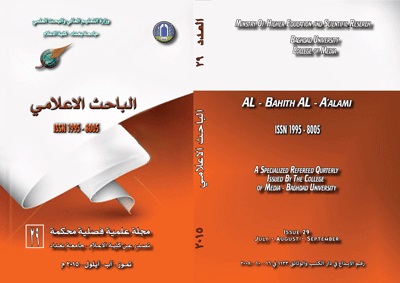Favorite TV Channels / as News Sources for Iraqi University Professors.
DOI:
https://doi.org/10.33282/abaa.v7i29.187Keywords:
Favorite TV, Channels, News Sources, Iraqi, University Professors.Abstract
The growing ability of Television to transfer and present events as they occur and sometimes transfer events alive makes it the most important sources to receive news and find out what is going on in the world. These channels form the importance of multiple sources and displayed content, especially news. What adds to the importance of the research is that the people under study are Iraqi professors
The problem of the study is represented by an essential inquiry about the favorite satellite channels to obtain news for Iraqi professors
The aims of the study are identified by finding out the most favorite satellite channels as a source of news for Iraqi professors and the habits of exposer to the news by them
The research is a descriptive study depending on the survey method to analyze the event under study. The researcher uses the questionnaire as a basic tool for gathering information. She/he distributed 360 questionnaires on chosen professors at three universities (Al-Anbbar University, Al-Mustansiriya University, and Babyl University)
The most important results are as follows: al-Iraqia, al-Sharqiya, al-Arabiya, Al-Jazeera, and al-Arabiya al-hadath get the first five mattresses as a source of news for male Iraqi professors, and al-Sharqiya, al-Arabiya, al-Iraqia, al-Jazeera, and al-Arabiya al-hadath get the first five mattresses as a source of news for female Iraqi professors
Downloads
References
* - a. Dr. Wahib al-Kubaisi / Psychology / Faculty of the Arts / University of Baghdad.
D. Fawzi Hadi Hindawi / Media / College of the Languages / University of Baghdad.
D. Kamel Ali Hassoun Al-Qayyim / Media / Faculty of Arts / Babylon University.
2 - Iman Farouk Mohamed Sayyad, adoption of the Egyptian elite on the media in the time of crises and disasters, Master Thesis, Ain Shams University, 2002.
3 - Adel Abdel Ghaffar, Evaluation of the Professional Performance of Arab News Satellite Channels, International Media Academy Conference, Cairo, The Egyptian Lebanese Library, 2005.
4- Najla Abdel-Hamid Fahmy, Motives for the Use of the Cultural elite of specialized media outlets, Master Thesis, Cairo University, Faculty of Information, 2006.
5 - Ayman Mahmoud Abu Zeid, the adoption of Egyptian scenes on satellite channels during the crises, Master of the University of Cairo, Faculty of Information, 2006.
6 - Heba Hussein Abdel Wahab, levels of credibility of Arab and foreign news channels as seen by the elite, MA, Cairo University, Faculty of Information, 2010.
7- Dr. Wahib Majeed Al-Kubaisi, Methods of Scientific Research Between Endoscopy and Application (Baghdad, Al-Yamamah Press Office, 2011) p. 31.
8- Dr. Samir Mohamed Hussein, Media Research, Foundations and Principles (Cairo, World of Books, 1976) p. 123.
9- Dr. Shahinaz Talaat, Media and Social Development (Cairo, The Anglo-Egyptian Library, 1980) p 79.
10. Charles Wright, The Social Perspective of Mass Communication, Muhammad Fathi's Translation (Cairo, Egyptian General Book Organization, 1983), p.
11- Dr. Sulaiman Saleh, Media Ethics, i2 (Kuwait: Al Falah Library, 2005) p. 255.
12. Mohamed Saad Abu Amoud, Political Functions of the Media, Egyptian Journal of Media Studies (Issue 50, March 1988), p.
13. Walter Ripson, The Rise of Sovereignty, translated by Samir Ezzat Nassar (Amman, Dar al-Nesr Publishing, 1995).
14- Dr. Al-Maseef and Nas, The tyranny of communication, Journal of Arab Radio (No. 4, June 2000) p.
15. Charles Wright, op cit., P. 24.
16. Ibid., P.
17. Zayed Center for Coordination and Follow-up, Media and Citizen Concerns, Research presented to the Symposium on the Use of Modern Technologies in Communication Development, Abu Dhabi, 18, 2, 2003.
18- Mohamed Hossam El-Din, Social Responsibility of the Egyptian Press, Master Thesis, Cairo University, Faculty of Information, 1996, p. 75 76.
9- Dr. Anhrah Al-Shall, International Media via Satellite (Cairo, Arab Thought House, 1986) p. 302.
20- d. Abdul Aziz Al-Ghannam, Introduction to Journalism, C2 (Cairo, The Anglo-Egyptian Library, 1983) p.
21 Ibid., P.
22- Dr. Adib Khadour, The Physiology of Entertainment in Television (Damascus, edyeb Khadour Publications, 1997) p. 46.
23- Dr. Adib Khaddour, same source, p. 46.
24- Dr. Anshrah Al-Shall, a source mentioned above, p. 302.
25- Dr. Adeeb Khaddour, source, p. 46.
26- Dr. Faraj Kamel, The Influence of Communication Means, Psychological and Social Basis (Cairo, Dar Al-Fikr Al-Arabi, 1985) p.
27- Dr. Jihan Rashti, The Foundations of Scientific Theory of Information, II (Cairo, Cairo University Press, 1978), p. 165.
28- Safaa Ali Jabbar Al-Rubaie, Adoption of the elite in Iraq on Iraqi satellite channels and social networking sites during security crises, Master thesis, Institute of Arab Research and Studies, Cairo, 2012.
29. d. Mohamed Abdel Hamid, Theories of Media and Influence Trends (Cairo, World of Books, 2004) p. 303.
30- d. Hassan Imad Makkawi and Lili Hussein, Communication and Contemporary Theories (Cairo, The Egyptian Lebanese Library, 2009) p. 314.
31. Dr. Abdul Razzaq Mohammed Al-Dulaimi, The Art of Contemporary Media Editing (Amman, Dar Jarir Publishing and Distribution, 2010) p.
** If the researcher mentioned ten channels of (1-10) were given a numerical weight descending from (10-1), that is, the channel that took sequence 1 gave 10 degrees, and channel sequence number 2 was awarded 9 degrees, and sequence 3 gave 8 degrees and so on to the last sequence, and then the points of each channel were extracted or multiplied by multiplying the number of frequencies per channel × the weight of the order.
Key Dates
Published
Issue
Section
License
Copyright (c) 2015 حافظ ياسين الهيتي, أ.م.د

This work is licensed under a Creative Commons Attribution 4.0 International License.
Authors retain copyright and grant the journal right of first publication with the work simultaneously licensed under a Creative Commons Attribution License (CC BY 4.0) that allows sharing the work with recognition of authorship and initial publication in ABBA journal.


















